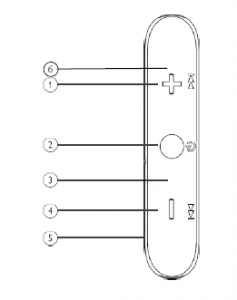PHILIPS Bluetooth in-ear Headphones User Manual
1.Important safety instructions
 Hearing Safety
Hearing Safety
anger
- Toavoid hearing damage, limit the time you use headphones at high volume and set the volume to a safelevel.The louder the volume, the shorter the safe listening time is.
Besure to observe the following guidelines when using your headset.
- Listen at reasonable volumes for reason- able periods of
- Becareful not to adjust the volume
continuously upwards asyour hearing adapts.
- Do not turn up the volume so high that you can’t hear what’s around
- You should usecaution or temporarily discontinue use in potentially hazardous
- Excessive sound pressure from earphones and headphones can
- Using headphones with both ears covered while driving is not recommended and may be illegal in some areas while
- For your safety, avoid distractions from musicor phone calls while in traffic or other potentially dangerous
General information
To avoid damage or malfunction
Caution
- Do not expose headphones to excessive heat Do not drop your headphones
- Headphones shall not be exposed to dripping or splashing.
- Do not allow your headphones to be submerged in water.
- Do not use any cleaning agents containing alcohol, ammonia, benzene, or abrasives.
- If cleaning is required use asoft doth, if necessary dampened with aminimum amount of water or diluted mild soap, to clean the product.
- The integrated battery shall not be exposed to excessive heat such assunshine, fire or the like. Danger of explosion if battery is incorrectly replaced. Replace only with the sameor equivalent type.
About operating and storage temperatures and humidity
- Operate or store in aplace where temperature is between -20°C (4°F) and 60°C (140 °F) (up to 90% relative
- Battery life may be shorter in high or low temperature
2 Your Bluetooth in-ear headphones
- Congratulations on your purchase, and welcome
- to Philips! To fully benefit from the support that Philips offers, register your product at www.philips.com/welcome.
- With this Philips wireless in-ear headphones, you can:
What’s in the box
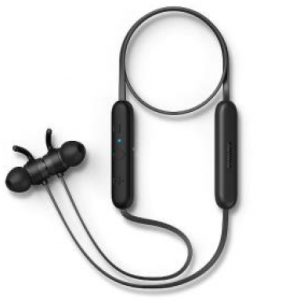
Philips Bluetooth in-ear headphones TAE1205
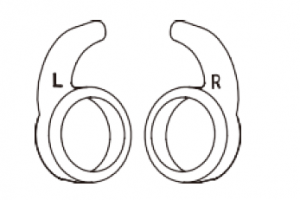 Earfins
Earfins
 caps ( S / L) *Caps (M size) are installed on TAE1205
caps ( S / L) *Caps (M size) are installed on TAE1205
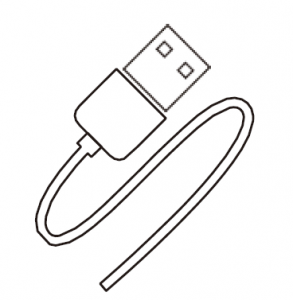
USBcharging cable (for charging only)

Quick start guide
Other devices
A mobile phone or device (e.g. notebook, PDA, Bluetooth adapters, MP3 players etc) which supports Bluetooth and iscompatible to the headphones (see ‘Technicaldata’ on page 7).
Overview of your Bluetooth in-ear headphone
- Next / Volume up
- music/call control button On/off,
- LED indicator CI Previous/Volume down
- Charging slot © MIC
3 Get started
Charge your headphones
NOTE
Before you use your headphones for the first time, charge the battery for 2 hours for optimum battery capacity and lifetime.Use only the original USB charging cable toavoid any damage.Finish your call before charging the headphones, as connecting the headphones for charging will power the headphones off.Connect the supplied USB charging cable to the charging slot on the headphones and the charger/USB port of a computer.LED turns white during charging and turns off when the headphones is fully chargedLED turns white during charging and turns off when the headphones is fully charged
Tip
- Normally, afull charge takes 2 hours.
Pair the headphones with your mobile phone
Before you use the headphones with your mobile phone for the first time, pair it with a mobile phone. A successful pairing establishes a unique encrypted link between the headphones and mobile phone.The headphones store the last 8 devices in the memory . If you try to pair more than 8 devices , the earliest pained device is replaced by the new one.
- Make sure that the headphones are fully charged and turned off.
- Press and hold the on/off button (>4s), blue and whites LED flashes alternately which means the headphones enter Bluetooth pairing mode. The headphones remain in pairing mode for 5 minutes.
- Make sure that the mobile phone is turned on and its Bluetooth feature is activated
- Pair the headphones with the mobile phone. For detailed information, refer to the user manual of your mobile phone.
Tip
Enter the headset password “0000” (4 zeros) if prompted. For those mobile phones featuring Bluetooth 3.0 or higher, no need to enter a password
4 Use your headphones
Connect the headphones to a Bluetooth device
- Turn on your mobile phone.
- Press and hold (>2s) the on/off button to turn the headphones on.
The headphones are reconnected to the last connected device automatically. If the last one is not available, the headphones try to reconnect to the second last connected device
- If you turn on the mobile phone or activate the Bluetooth feature after turning on the headphones, you have to reconnect the headphones and mobile phone
- If the headphones fail to connect to any Bluetooth device within range in 5 minutes, it will switch off automatically to save the battery
Manage your calls and music
Power on/off
| Turn on TAE1205 | On/Off, music/call control | Press and hold (>2s) |
| Turn off TAE1205 | On/Off, music/call control | Press and hold (>4s |
Music control
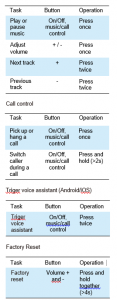
Summary of LED indicator
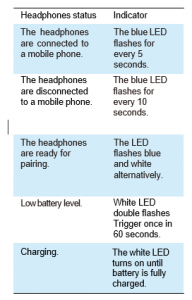
5 Technical data
- Music time: 7 hours
- Talk time: 5 hours
- Standby time: 60 hours
- Normal time for a full charge: 2 hours
- Battery: Rechargeable lithium polymer battery (100 mAh)
- Bluetooth version: Bluetooth 0
- Bluetooth profile: HSP, HFP, A2DP, AVRCP
- Operating range: Up to 10 meters (33 feet)
- Speaker driver: 6mm
- Frequency response: 20 – 20kHz
- Impedance: 32 ohm
- Sensitivity: 5db/1mW/1000Hz
- Distortion: <3%@1kHz THD
- Maximum power input: 5mW
6 Notice
Notice of compliance
Notice for USThe device complies with the FCC rules, PartOperation issubject to the following two conditions:This device maynot causeharmful interference, andThis device must accept any interference received, including interference that may causeundesiredoperation.
FCC rules
This equipment has been tested and found to comply with the limits for aClass Bdigital device, pursuant to part 15 of the FCC Rules. These limits are designed to provide reasonable protection against harmful interference in a residential installation. This equipment generates,usesand canradiate radio frequency energy and, if not installed and used in accordancewith the instruction manual, may cause harmful interference to radio communicationsHowever, there is no guarantee that interference will not occur in aparticular installation. If this equipment does cause harmful interference to radio or television reception, which can be determined by turning the equipment off and on, the user is encouraged to try to correct the interference by one or more of the following measures:Relocate the receiving antenna. In creasethe separation between equipment and receiverConnect the equipment into an outlet on acircuit different from that to which the receiver is connected.Consult the dealer or an experiencedradio/TV technician for help.FCCR adiation Exposure Statement:This equipment complies with FCC radiation exposure limits set forth for an uncontrolled environment .This transmitter must not beco-located or operating in conjunction with any other antenna or transmitter
Caution:The user iscautioned that changesor modifications not expressly approved by the party responsible for compliance could void the user’s authority to operate the equipment.
Notice for Canada:CAN ICES-3(B)/NMB-3(B)This device contains licence-exempt transmit- ter(s)/receiver(s) that comply with Innovation, Science and Economic Development Canada’s licence-exempt RSS(s). Operation is subject to the following two conditions:This device maynot causeinterference. 2.This device must accept anyinterference, including interference that maycauseundesired operation of the device.
Declaration of conformity
Hereby, MMD Hong Kong Holding Limited declares that this product is in compliance with the essential requirements and other relevant provisions of Directive 2014/53/EU.You canfind the Declaration of Conformity on www.p4c.philips.com.
Disposal of your old product and battery
This product may contain lead and mercury. Disposal of these materials may be regulated due to environmental considerations. For disposal or recycling information, please contact your local authorities or visit www.recycle. philips.com.This product contains non-removable batteries:
- Do not incinerate. Batteries may explode if overheated.
- For disposal or recycling information, please contact your local authorities or visit www.recycle.philips.com.
 Your product is designed and manufactured with high quality materials and components, which canbe recycled and reused.
Your product is designed and manufactured with high quality materials and components, which canbe recycled and reused.
 This symbol on a product means that the product is covered by European Directive 2012/19/EU
This symbol on a product means that the product is covered by European Directive 2012/19/EU

This symbol means that the product contains a built-in rechargeable battery covered by European Directive 2013/56/EU which cannot be disposedof with normal household waste. We strongly advise you to take your product to an official collection point or aPhilips service centre to have aprofessional remove the rechargeable battery.Inform yourself about the local separate
collection system for electrical and electronic products and rechargeable batteries. Follow local rules and never dispose of the product and rechargeable batteries with normal household waste. Correct disposal of old products and rechargeable batteries helps prevent negative consequences for the environment and human health.
Remove the integrated battery
If there is no collection/recycling systemfor electronic products in your country, you can protect the environment by removing and recycling the battery before disposing the headphones.
Compliance with EMF
This product complies with all applicable standards and regulations regarding exposure to electromagnetic fields.Environmental informationAll unnecessary packaging has been omitted. We have tried to make the packaging easy to separate into three materials: cardboard (box), polystyrene foam (buffer) and polyethylene (bags, protective foam sheet.)Your system consists of materials which canbe recycled and reused if disassembled by a specialized company. Please observe the local regulations regarding the disposal of packaging materials, exhausted batteries and old equipment.
Bluetooth
The Bluetooth® word mark and logos are registered trademarks owned by Bluetooth SIG,Inc. and anyuseof suchmarks by MMDHong Kong Holding Limited isunder license. Other trademarks and trade namesare those of their respective owners.
7 Frequently asked questions
My Bluetooth headphones do not switch on. The battery level is low. Charge the headphones.I cannot pair my Bluetooth headphones with a mobile phone. The Bluetooth isdisabled. Enablethe Bluetooth feature on your mobile phone and turn on the mobile phone before you turn on the headphones.
Pairing does not work.Make sure the headphones are in pairing mode.
- Follow the steps described in this user manual.
- Make sure that the LED light flashes blue and white alternately before your elease the call/music button. Do not stop holding the button if you seethe blue LED only.
The mobile phone cannot find the headphones. The headphones may be connected to a previously paired device .Turn off the connected device or move it out of range. Pairing may have been reset or the headphones have been previously paired with another device. Pair the headphones with the mobile phone again as described in the user manual.
My Bluetooth headphones are connected to a Bluetooth stereo enabled mobile phone, but musiconly plays on the mobile phone speaker. Refer to the user manual of your mobile phone. Select to listen to music through the headphones. The audio quality is poor and crackling noise can be heard.The Bluetooth device is out of range. Reduce the distance between your headphones and Bluetooth device, or remove obstacles between them. The audio quality is poor when streaming from the mobile phone is very slow, or audio streaming does not work at all. Make sure your mobile phone not only supports (mono) HSP/HFP but also supports A2DP (see ‘Technical data’ on page 7). I hear but cannot control music on my Bluetooth device (e.g. play/pause/skip forward/ backward). Make sure the Bluetooth audio source supports AVRCP (see ‘Technical data’ on page 7).For further support, visit www.philips.com/ support.
Read More About This Manual & Download PDF:
References
Philips – United States | Philips
Product registration | Philips
Anatel — Português (Brasil)
Electronic reuse and recycling – Sustainability | Philips
Philips – United States | Philips
Anatel — Português (Brasil)
Electronics reuse and recycling | Philips
Support location selector
Philips Global Consumer Care – Royal Philips Electronics
Philips Global Consumer Care – Royal Philips Electronics
[xyz-ips snippet=”download-snippet”]

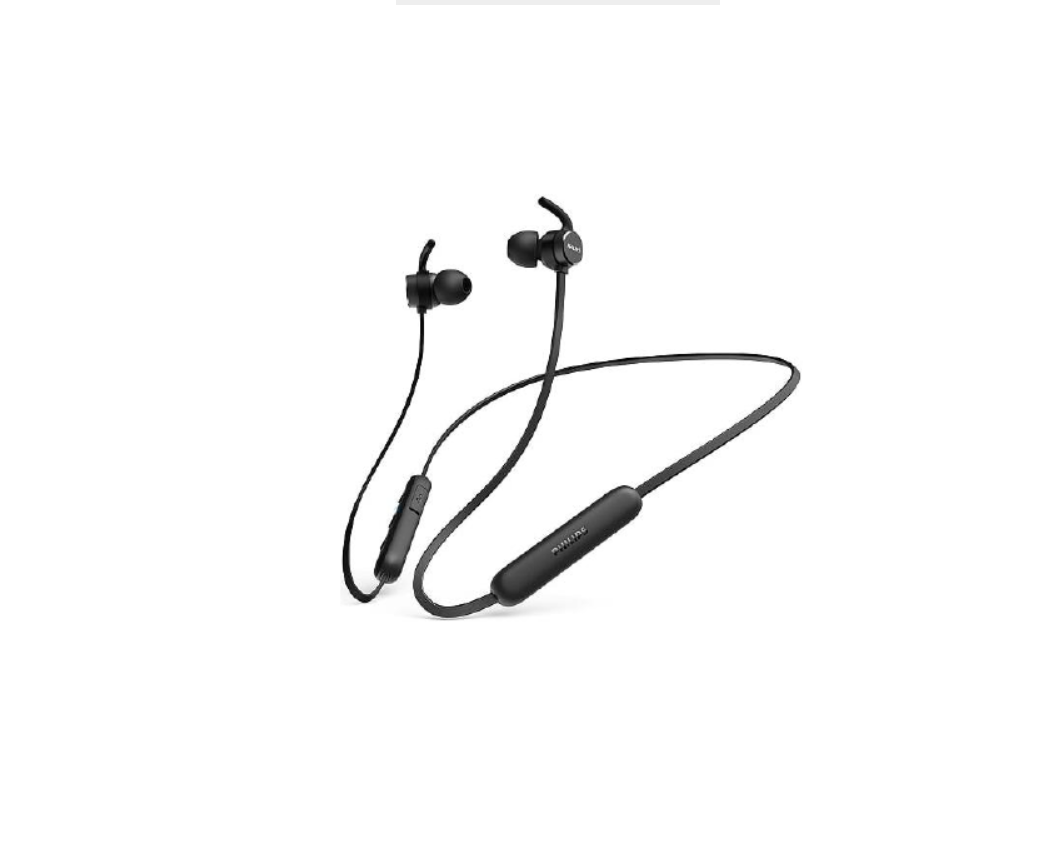
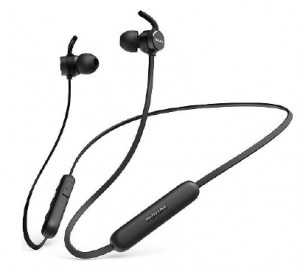
 Hearing Safety
Hearing Safety